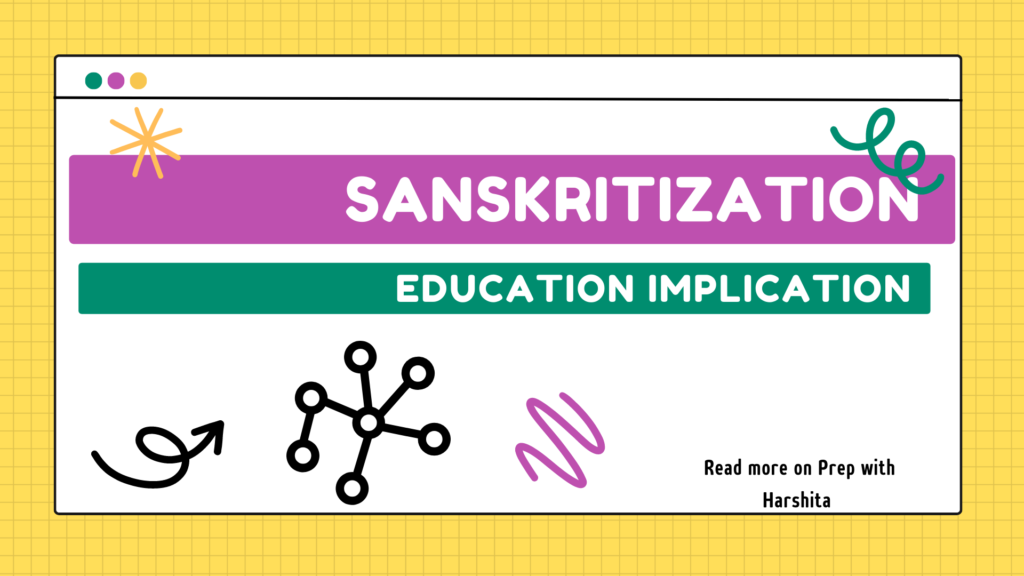Sanskritization is a sociocultural process that has been observed in Indian society, particularly in the context of caste dynamics.
Main Points about Sanskritization :
- Definition: Sanskritization, a term coined by sociologist M.N. Srinivas, refers to the process through which lower-caste individuals or communities adopt the customs, rituals, practices, and values of higher castes in an attempt to improve their social status. The term “Sanskritization” draws from the influence of Brahmanical (Brahmin) culture, as Sanskrit was the language associated with upper-caste rituals, religious texts, and cultural practices.
- Social Mobility: Sanskritization is driven by the aspiration for social mobility and the desire to escape the disadvantages and discrimination faced by lower castes. By emulating the practices and behaviors of higher castes, individuals and communities aim to enhance their social acceptance and elevate their position within the caste hierarchy. Sanskritization offers a means for lower castes to gain upward mobility and improve their socioeconomic standing.
- Adoption of Upper-Caste Practices: Sanskritization involves the adoption of various aspects of upper-caste culture, including religious rituals, dietary practices, language, clothing, marriage customs, and educational pursuits. Lower-caste individuals may adopt Brahminical rituals, learn Sanskrit, adhere to Brahminical dietary restrictions, and seek education in traditional knowledge systems associated with higher castes.
- Caste Identity and Cultural Change: Sanskritization leads to changes in caste identities and cultural practices. Lower-caste individuals or communities may undergo a transformation in their cultural and social behavior, aligning themselves with upper-caste norms. This process often involves the reinterpretation and reformation of existing cultural practices to resemble those of the higher castes.
- Impact on Language and Education: Sanskritization has had an influence on language and education in Indian society. Sanskrit, being associated with higher castes, has historically been considered a prestigious language. As lower castes aspired to improve their social status, learning Sanskrit became a marker of upward mobility. Sanskritization has also influenced the educational aspirations of lower castes, with increased demand for education as a means to access social and economic opportunities.
- Challenges and Criticisms: Sanskritization has faced criticisms and challenges in Indian society. Critics argue that the process perpetuates and reinforces caste-based hierarchies and inequalities. Sanskritization also highlights the existing discrimination faced by lower castes, as they are compelled to adopt the practices of higher castes for social acceptance. Furthermore, it may lead to the marginalization or loss of distinct cultural identities and practices associated with lower castes.
- Intersection with Modernity: Sanskritization intersects with the forces of modernity and social change in Indian society. As India undergoes rapid economic development and globalization, the dynamics of caste and social mobility are evolving. While Sanskritization persists, there are also movements for social justice, affirmative action, and the empowerment of lower castes that challenge traditional caste hierarchies and promote equality and inclusivity.
Education implications of Sanskritization in Indian society include:
- Access to Education: Historically, access to education has been limited for lower-caste individuals due to social exclusion and discrimination. Sanskritization can lead to increased demand for education among lower castes, as they aspire to acquire the knowledge and skills associated with higher castes. This can contribute to greater emphasis on education and efforts to improve educational opportunities for marginalized communities.
- Influence on Curriculum: Sanskritization can influence the curriculum in educational institutions. The adoption of upper-caste practices and values may lead to the inclusion of certain cultural elements, traditions, and perspectives in the curriculum, while potentially marginalizing or omitting the contributions and histories of lower castes. This can perpetuate the dominance of upper-caste narratives and create a bias in the educational system.
- Social Mobility and Aspiration: Sanskritization reflects the aspirations of lower castes to achieve upward mobility and social recognition. Education plays a crucial role in facilitating social mobility by equipping individuals with knowledge and skills necessary for employment, entrepreneurship, and professional success. Sanskritization can lead to increased focus on education as a means to improve social status and opportunities for lower-caste individuals.
- Reinforcement of Caste Hierarchy: While Sanskritization may offer opportunities for some individuals to improve their social standing, it can also reinforce the hierarchical nature of the caste system. By emulating upper-caste practices, lower castes may inadvertently perpetuate the existing caste-based divisions and inequalities. Education can play a role in challenging these hierarchical structures by promoting social equality, inclusivity, and critical thinking.
- Cultural Identity and Assimilation: Sanskritization involves the adoption of upper-caste cultural practices and values, which can result in the dilution or loss of distinct lower-caste cultural identities. Education can play a significant role in preserving and promoting diverse cultural identities by including the histories, traditions, and contributions of all castes in the curriculum. It can help create an inclusive educational environment that values and respects the cultural diversity of Indian society.
To ensure a more equitable and inclusive educational system, it is important to address the implications of Sanskritization by promoting social justice, equal access to education, representation of diverse perspectives, and the celebration of all cultural identities. Efforts should be made to create an educational environment that fosters respect, understanding, and appreciation for all castes, while challenging discriminatory practices and promoting social equality.
Also Read : Cultural Determinants of Education

Also Visit: Prep with Harshita

